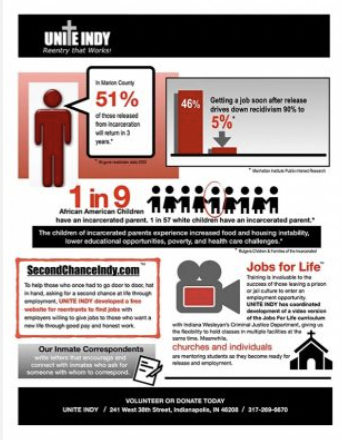 Click here for a full size version of the graphic.
Click here for a full size version of the graphic.
When you hear that 75 percent of the juveniles in prison come from fatherless homes, an alarm goes off. There is absolutely a tie between the lack of a father in the home and kids who get sent to prison. Here in Indianapolis, Fathers & Families Center offers a few more statistics: With a father in the home, a child is 75 percent less likely to have a teen birth, and 80 percent less likely to spend time in jail. People who think fathers are irrelevant just have their heads in the sand.
But there are other statistics that are important in the fight against recidivism and repeat crime. According to IN.gov public safety recidivism data, about 51 percent of those released from incarceration in Marion County were rearrested within three years.
When a parent goes to long-term incarceration, their children suffer too. One in nine African American children have an incarcerated parent, while only one in 57 white children have an incarcerated parent. But whether white or black, all these kids suffer increased food and housing instability, lower educational opportunities, poverty, and heath care challenges. Very few grow up with a "map" of supporting oneself through work that provides a foundation for economic advancement.
But here's some good news. According to the Manhattan Institute's Public-Interest Research findings, "Getting a job soon after release from incarceration drives down recidivism an average of 90 percent." Yes. 90 percent.
It has long been promoted that someone coming out of incarceration needs to find food, then a home then a long list of other things, and at the bottom of the list is work. But without work, the lack of income for food and a home soon can send a person back into illegal activity. Instead, we suggest folks flip the list and put work at the top. A job that pays well, in an atmosphere of understanding and flexibility, can put a solid foundation under a reentrant and his or her family in a way that nothing else can, while it provides funds for food and shelter and a path forward—not backward.
The landmark study by Butler University's Lacy School of Business found that there is no statistical difference between an employee with a criminal record and a one without. Forty-one of our employer partners are finding that to be true by listing their jobs on our SecondChanceIndy.com web site. As this effort spreads into the nine Central Indiana counties, there will be increased healing and redemption for those who have served time and improved security for children in the many homes affected by parental incarceration.
But more than that, all the players who have united in this effort, our government, our businesses, our volunteers and our own dedicated staff will be able to claim—with statistical evidence—that Central Indiana cares.
Nancy








